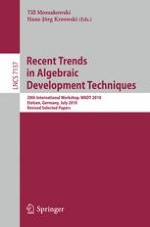This book constitutes the thoroughly refereed post-conference proceedings of the 20th International Workshop on Algebraic Development Techniques, WADT 2010, held in July 2010 in Etelsen, Germany. The 15 revised papers presented were carefully reviewed and selected from 32 presentations. The workshop deals with the following topics: foundations of algebraic specification; other approaches to formal specification including process calculi and models of concurrent, distributed and mobile computing; specification languages, methods, and environments; semantics of conceptual modeling methods and techniques; model-driven development; graph transformations, term rewriting and proof systems; integration of formal specification techniques; formal testing and quality assurance validation, and verification.
